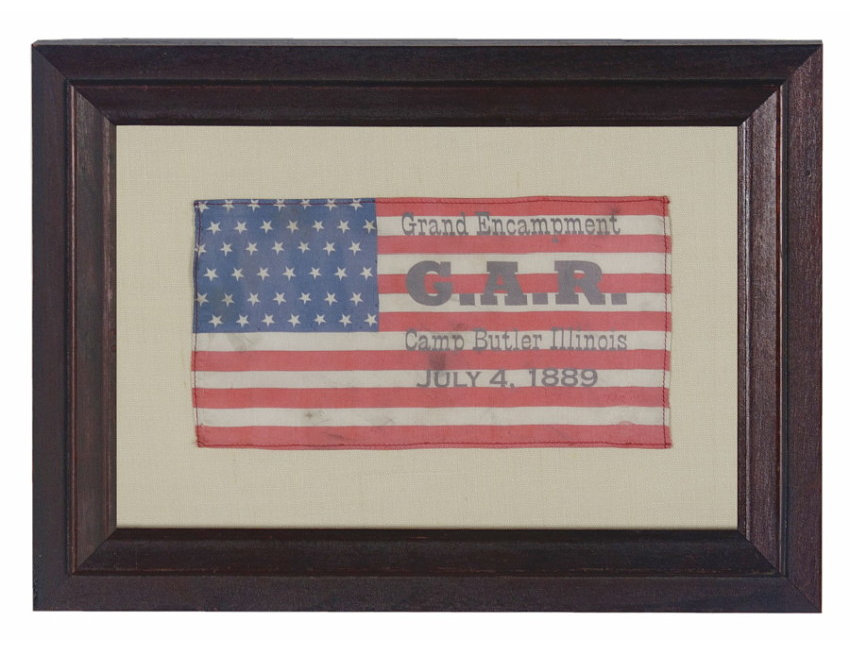|
42 STARS, A RARE EXAMPLE WITH AN ILLINOIS, CIVIL WAR, UNION ARMY VETERAN'S OVERPRINT, 1889:
|
|

|
Description: |
|
| 42 star American national parade flag, printed on silk, with a black inked overprint that reads:
Grand Encampment G.A.R.
Camp Butler Illinois, July 4th 1889
The stars are arranged in 7 staggered rows of 7 and are upside-down in their vertical alignment (with two points up instead of one). No one knows if this positioning had any purpose, but there was no official way to orient the stars and it is possible that the maker of this flag did not feel that any star position was �right-side-up�. Whatever the case may be, the feature does add a degree of interest to the design.
A similar flag exists from the same encampment and is documented in the book "The Stars & The Stripes: Fabric of the American Spirit" by Richard Pierce (J. Richard Pierce, LLC, 2005), p. 40. The fabric, size, and overprint all indicate that it was produced by the same maker, but its elements are different. For one, the stars of the flag are arranged in a medallion, comprised of a center star, surrounded by consecutive wreaths of stars, with a flanking star in each corner. Another difference is the profile of the flag, which has a V-shaped swallowtail at the fly end, to resemble U.S. cavalry guidons (small flags used to mark the flanks of cavalry units). The overprint on this flag is also slightly different. In the place of "Grand Encampment G.A.R., it instead reads: "7th Illinois Calvary G.A.R. Encampment". Each of these two flags exists as the only known example.
The G.A.R., or Grand Army of the Republic, was the primary association for Civil War veterans of the Union Army. Founded in 1866, it was similar to today�s American Legion or V.F.W., but more fraternal in nature.
As a group, parade flags with generic G.A.R. overprints are somewhat common. Parade flags with overprints from particular chapters of the G.A.R. are a bit more scarce. Flags with overprints from particular encampments and particular units are quite rare, which makes this example a lot more interesting than the standard fare. In addition, G.A.R. flags with overprinted advertising are unusual in the 42 star count.
The 42 star flag is interesting from a historical perspective, both because 42 was never an official star count, and because 42 star flags were only produced for about 8 months (November, 1889 � July 4th, 1890). The flag represents the addition of the Dakotas, Montana and Washington, between November 2nd and November 11th, 1889. The 42nd state was officially Washington, but the four states gained their statehood only nine days apart, and flag makers added four stars, accordingly, to the 38 star flag that was previously official.
After 1818, star counts became official on the 4th of July each year. A new star was therefore officially added on Independence Day for every state that had been added over the preceding �flag year�. Flag makers, however, did not wait for Independence Day and �official� star counts. Flag making was a competitive industry, and no one wanted to be making 38 star flags, for example, when their competitors were making 42 star flags and there were 42 states. On many occasions, particularly in the last quarter of the 19th century and the first decade of the 20th century, flag-makers would speculate the number of states that were going to be added and add the stars before they were official. It was for this precise reason that 42 was never an official star count. Idaho received statehood on July 3rd, 1890, taking the star count to 43 just one day before 42 would have become the official number. This fact makes 42 star flags an interesting part of our heritage and a classic display of American capitalism.
Mounting: The red-painted American frame has excellent surface. made of birch, it dates to the 2nd half of the 19th century. The flag has been hand-stitched to 100% hemp fabric. Spacers keep the textile away from the glazing, which is U.V. protective glass. |
| Inventory Number: |
|
|
|
Dealer |
Jeff R. Bridgman American Antiques, llc |
| Contact |
Jeff Bridgman |
Phone: (717) 502-1281 |
|
| Period: |
19th Century (1801-1900) |
|
| Date: |
1889 |
|
| Origin: |
US |
|
| Condition: |
There is some fading of the blue canton and the black overprint. There are a few minor to moderate stains and there is a minor area of fabric breakdown in the lower corner of the fly end. |
|
| Measurements: |
Frame: 11.75" x 16" Flag: 5.25" x 9.5" |
|
| Inventory |
Other Inventory by this Dealer |
|
| Web-site: |
http://www.jeffbridgman.com |
|
| Price: |
SOLD |
|
| E-mail: |
Inquire
|
|
Click thumbnail
to view larger
|
Views: 2762 |
|
|
|
